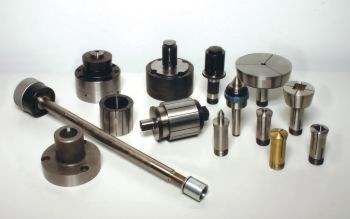Alternate Gripping Methods For Grinding Machines
Are you using your grinding machine to its full job capacity? Machine operators don't often think past centers, arbors, fixtures and magnetic chucks. Many shops are still doing second operation work when they could be set up to finish parts complete with an alternate workholding method. Here are several suggestions for additional or improved gripping solutions.
Share




Are you using your grinding machine to its full job capacity? Machine operators don't often think past centers, arbors, fixtures and magnetic chucks. Many shops are still doing second operation work when they could be set up to finish parts complete with an alternate workholding method. Here are several suggestions for additional or improved gripping solutions.
Morse taper, B&S taper and Jarno taper grinding machines can be adapted to use collets, step chucks, pin step chucks, expanding collets, "Dead-Length" collets, "Dead-Length" work stops, collet chucks, manual chucks, magnetic chucks, face plates and fixture plates. Hardinge (Elmira, New York) manufactures custom collet sleeves or adapters to fit in the spindle of the workhead to accept a useful variety of gripping products, even for the older grinding machines.
Kellenberger (St. Gallen, Switzerland), a Hardinge company, incorporates a combination A2-5/MT5 workhead spindle nose in its line of grinding machines to take advantage of 5C spindle tooling, according to Jeff Hilliard, sales manager for the Hardinge Grinding Group. "The optional adapter allows the customer access to an array of stock 5C tooling for increased gripping options." 5C spindle tooling includes collets, step chucks, emergency collets, fixtures, face plates and Hardinge's Sure-Grip expanding collet systems.
Hardinge says this expanding collet system is useful for OD grinding. It performs true parallel gripping with instant centering of the workpiece. Stock products are available to accommodate work from 1/8 inch to 4 inches in diameter. It is also possible to access the full grinding length of the workpiece, unlike with a fixture or chuck setup. The hardened and ground expanding collet head can be reground in place to the desired size for the best possible concentricity scenario to achieve zero TIR. Many jobs later, it can then be reground or recycled to accept a smaller ID workpiece for a different job setup. Expanding collet heads of varying sizes fit on the same collet body and are quickly changed from the front without removing the collet body.
The expanding collet has many advantages over a manual chuck or fixture setup. The setup time is decreased because of instant centering without individual clamping; the unit is smaller, lighter and mounts faster; and you can achieve the highest accuracy possible. Collets are available in 1/64-inch increments and a full range of metric sizes. The range of each collet is +0.015 inch to -0.001 inch (+0.38 mm to -0.025 mm) from its specified size. The company's Sure-Grip expanding arbors can be used between centers instead of tapered arbors to achieve a grip with more contact area. Users can load a part on a second, spare arbor for quicker part change-over.
Step chucks are handy devices for holding parts larger than the 1-inch diameter 5C capacity. Job shops can purchase emergency step chucks and grind them to size, matching the spindle bearings of the machine to achieve the best TIR possible. Hardened and ground steel step chucks can be ordered to size for specific applications. Similar to expanding collets, they can also be recycled for another job.
In comparison to manual chucks, step chucks offer faster part change-over considering the time involved in opening and closing a manual chuck with a wrench. A step chuck can be more economical, given that a set of jaws typically costs more than an emergency step chuck. Repeatability and part roundness are more accurate on the step chuck. Custom pin step chucks have steel pins in the collet closer that are ground to a desired stop location for part length control. Custom extra-depth step chucks are used to "swallow" a longer workpiece for precision ID grinding purposes, providing a larger gripping area. These are commonly used when the 3 to 1 ratio is exceeded. For example, if you have a part that is 1 inch in diameter and it exceeds 3 inches in length, you would introduce chatter and runout using traditional gripping methods. If your part exceeds the 3 to 1 ratio, use an extra-depth step chuck to hold the part more rigidly.
Custom spindle fixtures are smart solutions for high-production facilities running the same part around the clock. The fixture accepts the part in a fixed loading position, eliminating manual positioning and setup time that would occur using a magnetic chuck or jaw chuck. In high production situations, the accumulated time saved during loading of parts will substantially increase the parts output per hour. For small runs and job shop work, inexpensive blank fixture plates are available from 3- to 12-inch diameters. The clamping method is designed, machined and balanced by the job shop and is commonly used for odd shapes. Universal faceplates are perfect for holding non-ferrous materials that cannot be held with a magnetic chuck. Small angle plates position in four channels for clamping materials such as plastic, glass, ceramic, carbide and aluminum.
Read Next
Setting Up the Building Blocks for a Digital Factory
Woodward Inc. spent over a year developing an API to connect machines to its digital factory. Caron Engineering’s MiConnect has cut most of this process while also granting the shop greater access to machine information.
Read More5 Rules of Thumb for Buying CNC Machine Tools
Use these tips to carefully plan your machine tool purchases and to avoid regretting your decision later.
Read MoreBuilding Out a Foundation for Student Machinists
Autodesk and Haas have teamed up to produce an introductory course for students that covers the basics of CAD, CAM and CNC while providing them with a portfolio part.
Read More
























.jpg;maxWidth=300;quality=90)







